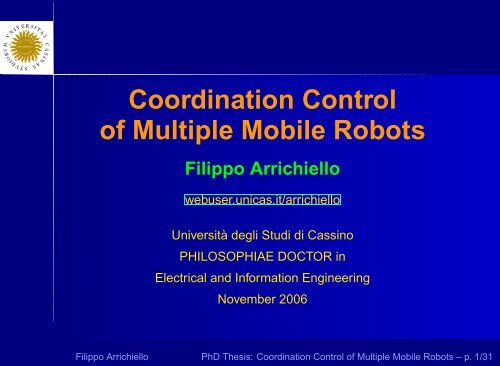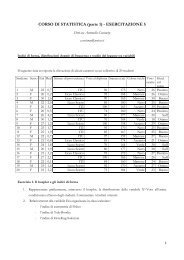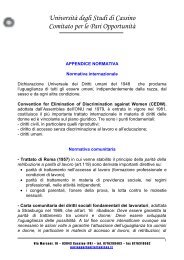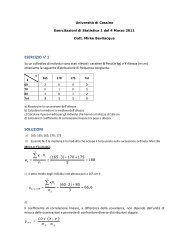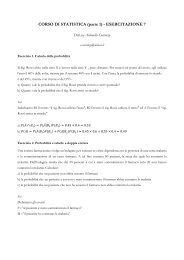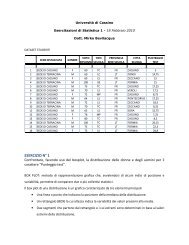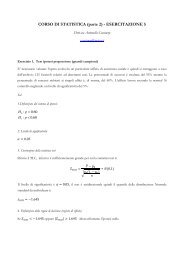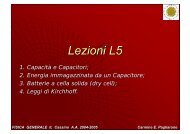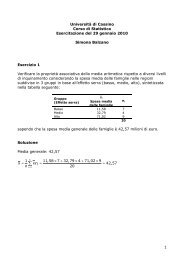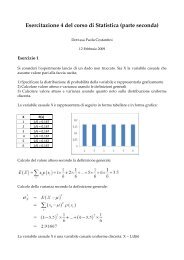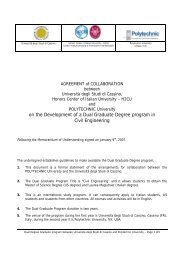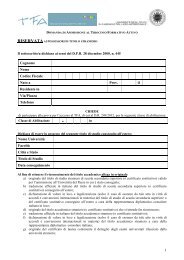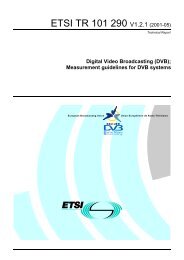Slides - Università degli Studi di Cassino
Slides - Università degli Studi di Cassino
Slides - Università degli Studi di Cassino
Create successful ePaper yourself
Turn your PDF publications into a flip-book with our unique Google optimized e-Paper software.
Coor<strong>di</strong>nation Control<br />
of Multiple Mobile Robots<br />
Filippo Arrichiello<br />
webuser.unicas.it/arrichiello<br />
<strong>Università</strong> <strong>degli</strong> <strong>Stu<strong>di</strong></strong> <strong>di</strong> <strong>Cassino</strong><br />
PHILOSOPHIAE DOCTOR in<br />
Electrical and Information Engineering<br />
November 2006<br />
Filippo Arrichiello PhD Thesis: Coor<strong>di</strong>nation Control of Multiple Mobile Robots – p. 1/31
Outline<br />
→ Introduction on Multi-Robot Systems<br />
→ The Null-Space-based Behavioral control (NSB)<br />
→ NSB for the control of a team of grounded mobile robots<br />
→ NSB for the control of a fleet of marine surface vessels<br />
→ NSB for the control of a team of mobile antennas<br />
→ Conclusions<br />
Filippo Arrichiello PhD Thesis: Coor<strong>di</strong>nation Control of Multiple Mobile Robots – p. 2/31
Motivations<br />
→ Increasing the mission efficiency<br />
→ Performing tasks not executable by a single robot<br />
→ Tolerance to possible vehicles’ faults<br />
→ Increasing the flexibility of tasks’ execution<br />
→ Advantages of <strong>di</strong>stributed sensing and actuation<br />
Filippo Arrichiello PhD Thesis: Coor<strong>di</strong>nation Control of Multiple Mobile Robots – p. 3/31
Applications<br />
→ Explorations<br />
→ Box-pushing<br />
→ Localization and Mapping<br />
→ Rescue Operations<br />
→ Military Tasks<br />
→ Entertainment (e.g., Robocup)<br />
Filippo Arrichiello PhD Thesis: Coor<strong>di</strong>nation Control of Multiple Mobile Robots – p. 4/31
Vehicles’ typologies<br />
→ Grounded Mobile Robots<br />
→ Marine robots<br />
→ Aerial Vehicles<br />
Filippo Arrichiello PhD Thesis: Coor<strong>di</strong>nation Control of Multiple Mobile Robots – p. 5/31
Approcci comportamentali<br />
→ Biological Inspiration<br />
→ Making the robots<br />
behave like animals<br />
Filippo Arrichiello PhD Thesis: Coor<strong>di</strong>nation Control of Multiple Mobile Robots – p. 6/31
Behavioral approaches<br />
Composition of the behaviors:<br />
Filippo Arrichiello PhD Thesis: Coor<strong>di</strong>nation Control of Multiple Mobile Robots – p. 7/31
Behavioral approaches<br />
Composition of the behaviors:<br />
Competitive approaches selective activation of the behaviors<br />
Filippo Arrichiello PhD Thesis: Coor<strong>di</strong>nation Control of Multiple Mobile Robots – p. 7/31
Behavioral approaches<br />
Composition of the behaviors:<br />
Competitive approaches selective activation of the behaviors<br />
Cooperative approaches the behaviors are combined with proper weights<br />
Filippo Arrichiello PhD Thesis: Coor<strong>di</strong>nation Control of Multiple Mobile Robots – p. 7/31
Behavioral approaches<br />
Composition of the behaviors:<br />
Competitive approaches selective activation of the behaviors<br />
Cooperative approaches the behaviors are combined with proper weights<br />
Null-Space-Based approach Following the task priority inverse kinematics, a<br />
hierarchy-based technique is adopted based on null-space projection<br />
Filippo Arrichiello PhD Thesis: Coor<strong>di</strong>nation Control of Multiple Mobile Robots – p. 7/31
Behavioral approaches<br />
Composition of the behaviors:<br />
Competitive approaches selective activation of the behaviors<br />
Cooperative approaches the behaviors are combined with proper weights<br />
Null-Space-Based approach Following the task priority inverse kinematics, a<br />
hierarchy-based technique is adopted based on null-space projection The<br />
NSB behavioral control <strong>di</strong>ffers from the other behavioral approaches in<br />
the way it combines multiple behaviors<br />
Filippo Arrichiello PhD Thesis: Coor<strong>di</strong>nation Control of Multiple Mobile Robots – p. 7/31
NSB control<br />
→ The mission is decomposed in elementary behaviors or tasks<br />
Filippo Arrichiello PhD Thesis: Coor<strong>di</strong>nation Control of Multiple Mobile Robots – p. 8/31
NSB control<br />
→ The mission is decomposed in elementary behaviors or tasks<br />
→ For each elementary behavior a task function is properly defined<br />
σ = f(p 1 , . . . ,p n )<br />
˙σ =<br />
n∑<br />
i=1<br />
∂f(p)<br />
∂p i<br />
v i = J(p)v<br />
Filippo Arrichiello PhD Thesis: Coor<strong>di</strong>nation Control of Multiple Mobile Robots – p. 8/31
NSB control<br />
→ The mission is decomposed in elementary behaviors or tasks<br />
→ For each elementary behavior a task function is properly defined<br />
σ = f(p 1 , . . . ,p n )<br />
˙σ =<br />
n∑<br />
i=1<br />
∂f(p)<br />
∂p i<br />
v i = J(p)v<br />
and a motion reference command to each vehicle is elaborated<br />
v d = J †( )<br />
˙σ d + Λ˜σ<br />
˜σ = σ d −σ<br />
Filippo Arrichiello PhD Thesis: Coor<strong>di</strong>nation Control of Multiple Mobile Robots – p. 8/31
NSB: Merging <strong>di</strong>fferent tasks<br />
→ To simultaneously handle <strong>di</strong>fferent, eventually conflicting, tasks the NSB<br />
adopts a singularity-robust task priority inverse kinematics technique<br />
v d<br />
( ) ) ( )<br />
= J † p ˙σ p,d + Λ p ˜σ p +<br />
(I − J † pJ p J † s ˙σ s,d + Λ s ˜σ s<br />
} {{ } } {{ } } {{ }<br />
primary null-Space secondary<br />
Filippo Arrichiello PhD Thesis: Coor<strong>di</strong>nation Control of Multiple Mobile Robots – p. 9/31
NSB: Merging <strong>di</strong>fferent tasks<br />
→ To simultaneously handle <strong>di</strong>fferent, eventually conflicting, tasks the NSB<br />
adopts a singularity-robust task priority inverse kinematics technique<br />
v d<br />
( ) ) ( )<br />
= J † p ˙σ p,d + Λ p ˜σ p +<br />
(I − J † pJ p J † s ˙σ s,d + Λ s ˜σ s<br />
} {{ } } {{ } } {{ }<br />
→ Three-task example:<br />
v i<br />
= J † i<br />
primary null-Space secondary<br />
(<br />
v d = v 1 +<br />
˙σ i,d + Λ i ˜σ i<br />
)<br />
( ) [<br />
I − J † 1 J 1 v 2 +<br />
(i = 1,2,3)<br />
( ) ]<br />
I − J † 2 J 2 v 3<br />
Filippo Arrichiello PhD Thesis: Coor<strong>di</strong>nation Control of Multiple Mobile Robots – p. 9/31
Implementation aspects<br />
NSB<br />
NSB + Vehicles’ Control<br />
Filippo Arrichiello PhD Thesis: Coor<strong>di</strong>nation Control of Multiple Mobile Robots – p. 10/31
Multi-robot: elementary behaviors<br />
Definition of the task functions: “Barycenter”<br />
σ b<br />
= f b (p 1 , . . . , p n ) = 1 n<br />
n∑<br />
i=1<br />
p i<br />
n∑ ∂f<br />
˙σ b = b (p)<br />
v i = J b (p) v<br />
∂p<br />
i=1 i<br />
⎡<br />
⎤<br />
J b = 1 ⎣ 1 0 1 0<br />
. . . ⎦<br />
n 0 1 0 1<br />
J † b = nJT b<br />
v b<br />
= J † b<br />
(<br />
˙σ b,d + Λ b ˜σ b<br />
)<br />
Filippo Arrichiello PhD Thesis: Coor<strong>di</strong>nation Control of Multiple Mobile Robots – p. 11/31
Multi-robot: elementary behaviors<br />
Definition of the task functions: “Rigid Formation”<br />
σ f =<br />
⎡<br />
⎢<br />
⎣<br />
⎤<br />
p 1 − p b<br />
. ⎥<br />
⎦<br />
p n − p b<br />
v f = J f Λ f ˜σ f<br />
⎡<br />
⎤<br />
J f =<br />
⎡<br />
⎣ A O<br />
O A<br />
⎤<br />
⎦ A =<br />
⎢<br />
⎣<br />
1− 1 n<br />
− 1 n<br />
. . . − 1 n<br />
− 1 n<br />
.<br />
1− 1 n<br />
. . . − 1 n<br />
.<br />
. . .<br />
. ..<br />
⎥<br />
⎦<br />
J † f = J f<br />
− 1 n<br />
− 1 n<br />
. . . 1− 1 n<br />
Filippo Arrichiello PhD Thesis: Coor<strong>di</strong>nation Control of Multiple Mobile Robots – p. 11/31
Multi-robot: elementary behaviors<br />
Definition of the task functions: “Obstacle Avoidance”<br />
The obstacle avoidance task function is built in<strong>di</strong>vidually to each vehicle, i.e., it<br />
is not an aggregate task function<br />
σ o = ‖p − p o ‖ σ o,d = d J o = ˆr T J † o = ˆr<br />
p o : obstacle position<br />
d: safe <strong>di</strong>stance<br />
ˆr= p−p o<br />
‖p−p o<br />
‖<br />
: unit vector<br />
of the obstacle-to-vehicle <strong>di</strong>rection<br />
)<br />
v o = J † oλ o ˜σ o = λ o<br />
(d − ‖p−p o ‖ ˆr<br />
N(J o ) = I − ˆrˆr T<br />
Filippo Arrichiello PhD Thesis: Coor<strong>di</strong>nation Control of Multiple Mobile Robots – p. 11/31
Team of wheeled mobile robots<br />
→ Platoon of 7 Khepera II<br />
→ Differential-drive mobile robots<br />
→ Each robot has a Bluetooth turret<br />
Filippo Arrichiello PhD Thesis: Coor<strong>di</strong>nation Control of Multiple Mobile Robots – p. 12/31
Experimental set-up<br />
Filippo Arrichiello PhD Thesis: Coor<strong>di</strong>nation Control of Multiple Mobile Robots – p. 13/31
Experiments<br />
Mission 1: Obstacle-Barycenter-Linear Formation<br />
Movie 1<br />
Filippo Arrichiello PhD Thesis: Coor<strong>di</strong>nation Control of Multiple Mobile Robots – p. 14/31
Experiments<br />
Mission 1: Mission steps<br />
150<br />
150<br />
150<br />
150<br />
100<br />
100<br />
100<br />
100<br />
50<br />
50<br />
50<br />
50<br />
0<br />
0<br />
0<br />
0<br />
−50<br />
t = 27.58<br />
0 50 100 150<br />
−50<br />
t = 28.72<br />
0 50 100 150<br />
−50<br />
t = 29.93<br />
0 50 100 150<br />
−50<br />
t = 31.06<br />
0 50 100 150<br />
150<br />
150<br />
150<br />
150<br />
100<br />
100<br />
100<br />
100<br />
50<br />
50<br />
50<br />
50<br />
0<br />
0<br />
0<br />
0<br />
−50<br />
t = 32.29<br />
0 50 100 150<br />
−50<br />
t = 33.43<br />
0 50 100 150<br />
−50<br />
t = 34.53<br />
0 50 100 150<br />
−50<br />
t = 36.1<br />
0 50 100 150<br />
Movie 1<br />
Filippo Arrichiello PhD Thesis: Coor<strong>di</strong>nation Control of Multiple Mobile Robots – p. 14/31
Experiments<br />
Mission 1: Barycenter and rigid formation task function errors<br />
100<br />
100<br />
80<br />
80<br />
[cm]<br />
60<br />
40<br />
[cm]<br />
60<br />
40<br />
20<br />
20<br />
0<br />
0 10 20 30<br />
[s]<br />
0<br />
0 10 20 30<br />
[s]<br />
Movie 1<br />
Filippo Arrichiello PhD Thesis: Coor<strong>di</strong>nation Control of Multiple Mobile Robots – p. 14/31
Experiments<br />
Mission 2: Obstacle-Barycenter-Circular Formation<br />
Movie 2<br />
Filippo Arrichiello PhD Thesis: Coor<strong>di</strong>nation Control of Multiple Mobile Robots – p. 15/31
Experiments<br />
Mission 2: Mission steps<br />
t = 0 t = 5.9 t = 12.17 t = 18.49<br />
t = 24.99 t = 31.19 t = 37.56 t = 43.46<br />
t = 49.58 t = 55.69 t = 61.83 t = 67.84<br />
Movie 2<br />
Filippo Arrichiello PhD Thesis: Coor<strong>di</strong>nation Control of Multiple Mobile Robots – p. 15/31
Experiments<br />
Mission 2: Paths of the robots<br />
150<br />
100<br />
Y[cm]<br />
50<br />
0<br />
−50<br />
0 50 100 150<br />
X[cm]<br />
Movie 2<br />
Filippo Arrichiello PhD Thesis: Coor<strong>di</strong>nation Control of Multiple Mobile Robots – p. 15/31
Experiments<br />
Mission 2: Barycenter and Rigid Formation task function errors<br />
100<br />
150<br />
[cm]<br />
80<br />
60<br />
40<br />
20<br />
[cm]<br />
100<br />
50<br />
0<br />
0 20 40 60<br />
[s]<br />
0<br />
0 20 40 60<br />
[s]<br />
Movie 2<br />
Filippo Arrichiello PhD Thesis: Coor<strong>di</strong>nation Control of Multiple Mobile Robots – p. 15/31
Experiments<br />
Mission 3: Escorting/Entrapment mission<br />
Movie 3<br />
Filippo Arrichiello PhD Thesis: Coor<strong>di</strong>nation Control of Multiple Mobile Robots – p. 16/31
Feet of marine vessels<br />
→ Navigation in formation<br />
→ Autonomous navigation systems<br />
→ Harbor operations<br />
Filippo Arrichiello PhD Thesis: Coor<strong>di</strong>nation Control of Multiple Mobile Robots – p. 17/31
Guidance system<br />
→ Supervisor: Null-Space-based Behavioral control<br />
→ Maneuvering control<br />
Filippo Arrichiello PhD Thesis: Coor<strong>di</strong>nation Control of Multiple Mobile Robots – p. 18/31
Single-vessel modelling<br />
Kinematics<br />
n<br />
ψ<br />
χ<br />
u<br />
{B}<br />
β<br />
v<br />
U<br />
e<br />
ν = (u v r ) T linear and<br />
angular velocity in surge-swayyaw<br />
BODY components<br />
η = (n e ψ ) T position and<br />
orientation in the NE-plane<br />
˙η=R(ψ)ν<br />
Filippo Arrichiello PhD Thesis: Coor<strong>di</strong>nation Control of Multiple Mobile Robots – p. 19/31
Single-vessel modelling<br />
Dynamics<br />
M ˙ν + N(ν)ν = τ + R T (ψ)w<br />
Inertial Parameters<br />
Hydrodynamic Effects<br />
Environmental Disturbances:<br />
- Wind<br />
- Waves<br />
- Current<br />
Filippo Arrichiello PhD Thesis: Coor<strong>di</strong>nation Control of Multiple Mobile Robots – p. 20/31
Single-vessel modelling<br />
Actuation System<br />
→ Two main thrusters<br />
→ One tunnel thruster (for low-speed maneuvers)<br />
Filippo Arrichiello PhD Thesis: Coor<strong>di</strong>nation Control of Multiple Mobile Robots – p. 21/31
Single-vessel modelling<br />
Actuation System<br />
F 1<br />
Main Propellers<br />
Tunnel thrusters<br />
{BODY }<br />
F 2<br />
F 3<br />
τ2,max<br />
x 10 4<br />
4<br />
3<br />
2<br />
1<br />
b<br />
0<br />
0 1 2 3<br />
u<br />
Fully-Actuated<br />
⎡<br />
⎤<br />
Under-Actuated<br />
⎡<br />
⎤<br />
τ =<br />
⎢<br />
⎣<br />
F 1 + F 2<br />
F 3<br />
τ 3 (F 1 ,F 2 ,F 3 )<br />
⎥<br />
⎦<br />
τ =<br />
⎢<br />
⎣<br />
F 1 + F 2<br />
0<br />
τ 3 (F 1 ,F 2 )<br />
⎥<br />
⎦<br />
Filippo Arrichiello PhD Thesis: Coor<strong>di</strong>nation Control of Multiple Mobile Robots – p. 21/31
Maneuvering control<br />
τ = M ˙α + Nα − R T ŵ − hk 1 z 1 − K 2 z 2<br />
Filippo Arrichiello PhD Thesis: Coor<strong>di</strong>nation Control of Multiple Mobile Robots – p. 22/31
Maneuvering control<br />
τ = M ˙α + Nα − R T ŵ − hk 1 z 1 − K 2 z 2<br />
α =<br />
⎛<br />
⎜<br />
⎝<br />
U NSB cos(β NSB )<br />
α 2<br />
˙ψ NSB −z 1<br />
⎞<br />
⎟<br />
⎠<br />
β NSB<br />
α 2 =<br />
= χ NSB − ψ<br />
{<br />
UNSB sin(β NSB ) [FA]<br />
tale che τ 2 =0 [UA]<br />
Filippo Arrichiello PhD Thesis: Coor<strong>di</strong>nation Control of Multiple Mobile Robots – p. 22/31
Maneuvering control<br />
τ = M ˙α + Nα − R T ŵ − hk 1 z 1 − K 2 z 2<br />
α =<br />
⎛<br />
⎜<br />
⎝<br />
U NSB cos(β NSB )<br />
α 2<br />
˙ψ NSB −z 1<br />
⎞<br />
⎟<br />
⎠<br />
β NSB<br />
α 2 =<br />
= χ NSB − ψ<br />
{<br />
UNSB sin(β NSB ) [FA]<br />
tale che τ 2 =0 [UA]<br />
z 1 = ψ−ψ NSB k 1 > 0<br />
z 2 = ν−α K 2 > 0<br />
˙ŵ = ΓRz 2 Γ =Γ T > 0<br />
h =<br />
⎛<br />
⎜<br />
⎝<br />
0<br />
0<br />
1<br />
⎞<br />
⎟<br />
⎠<br />
Filippo Arrichiello PhD Thesis: Coor<strong>di</strong>nation Control of Multiple Mobile Robots – p. 22/31
Case stu<strong>di</strong>es<br />
Mission 1<br />
n[m]<br />
500<br />
400<br />
300<br />
200<br />
100<br />
0<br />
−100<br />
−200<br />
−300<br />
−400<br />
−500<br />
−200 0 200 400 600 800 1000<br />
e[m]<br />
n[m]<br />
500<br />
400<br />
300<br />
200<br />
100<br />
0<br />
−100<br />
−200<br />
−300<br />
−400<br />
−500<br />
−200 0 200 400 600 800 1000<br />
e[m]<br />
n[m]<br />
500<br />
400<br />
300<br />
200<br />
100<br />
0<br />
−100<br />
−200<br />
−300<br />
−400<br />
−500<br />
−200 0 200 400 600 800 1000<br />
e[m]<br />
n[m]<br />
500<br />
400<br />
300<br />
200<br />
100<br />
0<br />
−100<br />
−200<br />
−300<br />
−400<br />
−500<br />
−200 0 200 400 600 800 1000<br />
e[m]<br />
Simulation 1<br />
Filippo Arrichiello PhD Thesis: Coor<strong>di</strong>nation Control of Multiple Mobile Robots – p. 23/31
Case stu<strong>di</strong>es<br />
Mission 1<br />
500<br />
a<br />
30<br />
b<br />
25<br />
20<br />
n[m]<br />
0<br />
σ o<br />
15<br />
10<br />
5<br />
0<br />
−500<br />
0 500 1000<br />
e[m]<br />
−5<br />
0 200 400 600 800 1000<br />
t[s]<br />
40<br />
c<br />
150<br />
d<br />
30<br />
100<br />
σ b<br />
20<br />
10<br />
0<br />
σ f<br />
50<br />
0<br />
−50<br />
−100<br />
−10<br />
0 500 1000 1500 2000<br />
t[s]<br />
−150<br />
0 200 400 600 800 1000<br />
t[s]<br />
Simulation 1<br />
Filippo Arrichiello PhD Thesis: Coor<strong>di</strong>nation Control of Multiple Mobile Robots – p. 23/31
Case stu<strong>di</strong>es<br />
Mission 1<br />
τ [N]<br />
a)<br />
2<br />
1<br />
0<br />
−1<br />
−2<br />
−3<br />
0 500 1000 1500 2000 2500<br />
3 x t[s]<br />
θ [rad]<br />
2.5<br />
2<br />
1.5<br />
1<br />
0.5<br />
0<br />
−0.5<br />
−1<br />
b)<br />
−1.5<br />
0 500 1000 1500 2000 2500<br />
t[s]<br />
Simulation 1<br />
Filippo Arrichiello PhD Thesis: Coor<strong>di</strong>nation Control of Multiple Mobile Robots – p. 23/31
Case stu<strong>di</strong>es<br />
Mission 2<br />
n[m]<br />
500<br />
400<br />
300<br />
200<br />
100<br />
0<br />
−100<br />
−200<br />
−300<br />
−400<br />
−500<br />
−200 0 200 400 600 800 1000<br />
e[m]<br />
n[m]<br />
500<br />
400<br />
300<br />
200<br />
100<br />
0<br />
−100<br />
−200<br />
−300<br />
−400<br />
−500<br />
−200 0 200 400 600 800 1000<br />
e[m]<br />
n[m]<br />
500<br />
400<br />
300<br />
200<br />
100<br />
0<br />
−100<br />
−200<br />
−300<br />
−400<br />
−500<br />
−200 0 200 400 600 800 1000<br />
e[m]<br />
n[m]<br />
500<br />
400<br />
300<br />
200<br />
100<br />
0<br />
−100<br />
−200<br />
−300<br />
−400<br />
−500<br />
−200 0 200 400 600 800 1000<br />
e[m]<br />
Simulation 2<br />
Filippo Arrichiello PhD Thesis: Coor<strong>di</strong>nation Control of Multiple Mobile Robots – p. 24/31
Case stu<strong>di</strong>es<br />
Mission 2<br />
500<br />
a<br />
30<br />
b<br />
25<br />
20<br />
n[m]<br />
0<br />
σ o<br />
15<br />
10<br />
5<br />
−500<br />
0 500 1000<br />
e[m]<br />
0<br />
0 200 400 600 800 1000<br />
t[s]<br />
15<br />
c<br />
60<br />
d<br />
10<br />
40<br />
σ b<br />
5<br />
0<br />
−5<br />
−10<br />
σ f<br />
20<br />
0<br />
−20<br />
−15<br />
−40<br />
−20<br />
0 500 1000 1500 2000<br />
t[s]<br />
−60<br />
0 200 400 600 800 1000<br />
t[s]<br />
Simulation 2<br />
Filippo Arrichiello PhD Thesis: Coor<strong>di</strong>nation Control of Multiple Mobile Robots – p. 24/31
Case stu<strong>di</strong>es<br />
Mission 2<br />
τ [N]<br />
a)<br />
4<br />
3<br />
2<br />
1<br />
0<br />
−1<br />
−2<br />
−3<br />
0 500 1000 1500 2000 2500<br />
5 x t[s]<br />
θ [rad]<br />
2<br />
1<br />
0<br />
−1<br />
−2<br />
b)<br />
−3<br />
0 500 1000 1500 2000 2500<br />
t[s]<br />
Simulation 2<br />
Filippo Arrichiello PhD Thesis: Coor<strong>di</strong>nation Control of Multiple Mobile Robots – p. 24/31
Team of mobile antennas<br />
agent<br />
mobile antennas<br />
base station<br />
→ Mobile Ad-hoc NETworks (MANET)<br />
→ To guarantee coverage of an autonomous vehicle<br />
→ Platoon of robots carrying repeater antennas<br />
Filippo Arrichiello PhD Thesis: Coor<strong>di</strong>nation Control of Multiple Mobile Robots – p. 25/31
MANET<br />
rmax<br />
dmax<br />
dmin<br />
antenna<br />
→ Each antenna has a maximum communication range equal to r max<br />
→ Each antenna needs to be in a range [d min , d max ] from the other<br />
antennas<br />
Filippo Arrichiello PhD Thesis: Coor<strong>di</strong>nation Control of Multiple Mobile Robots – p. 26/31
MANET<br />
The task function aimed at ensuring connection of the chain is:<br />
σ c =<br />
σ c,i =<br />
J c,i =<br />
σ d,i =<br />
n∑<br />
i=1<br />
σ c,i<br />
⎧<br />
‖r‖ if ‖r‖≤d min<br />
⎪⎨<br />
0 if d min
MANET<br />
The tasks are organized in priorities :<br />
1. avoid the obstacles;<br />
2. keep the next antenna in the coverage area;<br />
3. keep the previous antenna in the coverage area.<br />
A supervisor is in charge of detecting when the moving robot is going outside<br />
the maximum MANET coverage and, eventually, mo<strong>di</strong>fying the tasks’ priorities<br />
or ad<strong>di</strong>ng/removing tasks<br />
The virtual chain is organized at each sampling time<br />
Simulations: Obstacles buil<strong>di</strong>ng<br />
Filippo Arrichiello PhD Thesis: Coor<strong>di</strong>nation Control of Multiple Mobile Robots – p. 28/31
Conclusions<br />
→ Introduction to multi-robot systems<br />
→ Description of the Null-Space-based Behavioral (NSB) control for the<br />
control of a generic multi-robot system<br />
→ Implementation of the NSB to control a team wheeled mobile robots<br />
performing several formation control missions with collision avoidance<br />
→ The NSB has been test in simulative case stu<strong>di</strong>es while controlling a fleet<br />
of marine surface vessels with a particular actuation system and a team<br />
of mobile antennas<br />
Filippo Arrichiello PhD Thesis: Coor<strong>di</strong>nation Control of Multiple Mobile Robots – p. 29/31
Conclusioni<br />
→ The experimental and simulative results prove the effectiveness and<br />
flexibility of the approach<br />
→ The NSB is well suitable to control several typologies of vehicles<br />
performing <strong>di</strong>fferent missions<br />
→ The NSB results robust to sensor noise, external <strong>di</strong>sturbances and<br />
non-static environment<br />
→ The NSB results dynamically scalable to the ad<strong>di</strong>ng or removing a vehicle<br />
from the team during the mission<br />
Filippo Arrichiello PhD Thesis: Coor<strong>di</strong>nation Control of Multiple Mobile Robots – p. 30/31
Publications<br />
Journal Papers:<br />
1. G. Antonelli, F. Arrichiello, S. Chiaverini, The Null-Space-Based Behavioral Control for Autonomous<br />
Robotic Systems, Journal of Intelligent Service Robotics,in press 2007<br />
2. G. Antonelli, F. Arrichiello, S. Chiaverini and R. Setola, Coor<strong>di</strong>nated control of mobile antennas for<br />
ad-hoc networks, International Journal of Modelling, Identification and Control, Special/Inaugural<br />
issue on Intelligent Robot Systems, Vol. 1, No. 1, pp.63-71, 2006<br />
Book Chapters<br />
1. F. Arrichiello, S. Chiaverini and T.I. Fossen, Formation Control of Marine Surface Vessels using the<br />
Null-Space-Based Behavioral Control, In Group Coor<strong>di</strong>nation and Cooperative Control<br />
(K.Y.Pettersen, T.Gravdahl, and H.Nijmeijer, Eds.). Lecture Notes in Control and Information<br />
Systems series, Springer-Verlag, pp.1-19, 2006<br />
Filippo Arrichiello PhD Thesis: Coor<strong>di</strong>nation Control of Multiple Mobile Robots – p. 31/31
Publications<br />
International Conference Papers (with review):<br />
11. G. Antonelli, F. Arrichiello, S. Chakraborty and S. Chiaverini, Experiences of formation control of<br />
multi-robot systems with the Null-Space-based Behavioral Control, Procee<strong>di</strong>ngs 2007 IEEE<br />
International Conference on Robotics and Automation, Rome, I, 2007.<br />
10. F. Arrichiello, S. Chiaverini and T.I. Fossen, Formation Control of Underactuated Surface Vessels using<br />
the Null-Space-Based Behavioral Control, Procee<strong>di</strong>ngs 2006 IEEE/RSJ International Conference on<br />
Intelligent Robots and Systems, Beijing, China, 2006<br />
9. G. Antonelli, F. Arrichiello, S. Chiaverini and K.J. Rao, Preliminary Experiments of Formation Control<br />
using the Null-Space-Based Behavioral Control, 8th IFAC Symposium on Robot Control, Bologna, I,<br />
2006<br />
8. G. Antonelli, F. Arrichiello, S. Chiaverini, Experiments of Formation Control with Collisions Avoidance<br />
using the Null-Space-Based Behavioral Control, 14th Me<strong>di</strong>terranean Conference on Control and<br />
Automation, Ancona, I, 2006<br />
7. F. Arrichiello, S. Chiaverini, A simulation package for coor<strong>di</strong>nated motion control of a fleet of<br />
under-actuated surface vessels, 5th MATHMOD Conference, Vienna, Austria, 2006<br />
Filippo Arrichiello PhD Thesis: Coor<strong>di</strong>nation Control of Multiple Mobile Robots – p. 31/31
Publications<br />
6. G. Antonelli, F. Arrichiello, S. Chiaverini and R. Setola, Coor<strong>di</strong>nated control of mobile antennas for<br />
ad-hoc networks in cluttered environments, 9th International Conference on Intelligent Autonomous<br />
Systems, Tokyo, J,2006<br />
5. G. Antonelli, F. Arrichiello, S. Chiaverini and R. Setola, A Self-Configuring MANET for Coverage Area<br />
Adaptation through Kinematic Control of a Platoon of Mobile Robots, IEEE/RSJ International<br />
Conference on Intelligent Robots and Systems, Edmonton, CA, pp.1332-1337, 2005<br />
4. G. Antonelli, F. Arrichiello and S. Chiaverini, The Null-Space-Based Behavioral Control for<br />
Soccer-Playing Mobile Robots, 2005 IEEE/ASME International Conference on Advanced Intelligent<br />
Mechatronics, Monterey, CA, pp.1257-1262, 2005<br />
3. G. Antonelli, F. Arrichiello and S. Chiaverini, Experimental kinematic comparison of behavioral<br />
approaches for mobile robots, 16th IFAC World Congress, Praha, CZ, 2005<br />
2. G. Antonelli, F. Arrichiello and S. Chiaverini, The Null-Space-Based behavioral control for mobile robots,<br />
IEEE International Symposium on Computational Intelligence in Robotics and Automation, Espoo,<br />
Finland, pp.15-20, 2005<br />
1. F. Arrichiello, S. Gerbino, How to investigate constraints and motions in assemblies by screw theory,<br />
Proc. of 4th CIRP ICME’04 Int. Conf., Sorrento, I, 2004<br />
Filippo Arrichiello PhD Thesis: Coor<strong>di</strong>nation Control of Multiple Mobile Robots – p. 31/31


